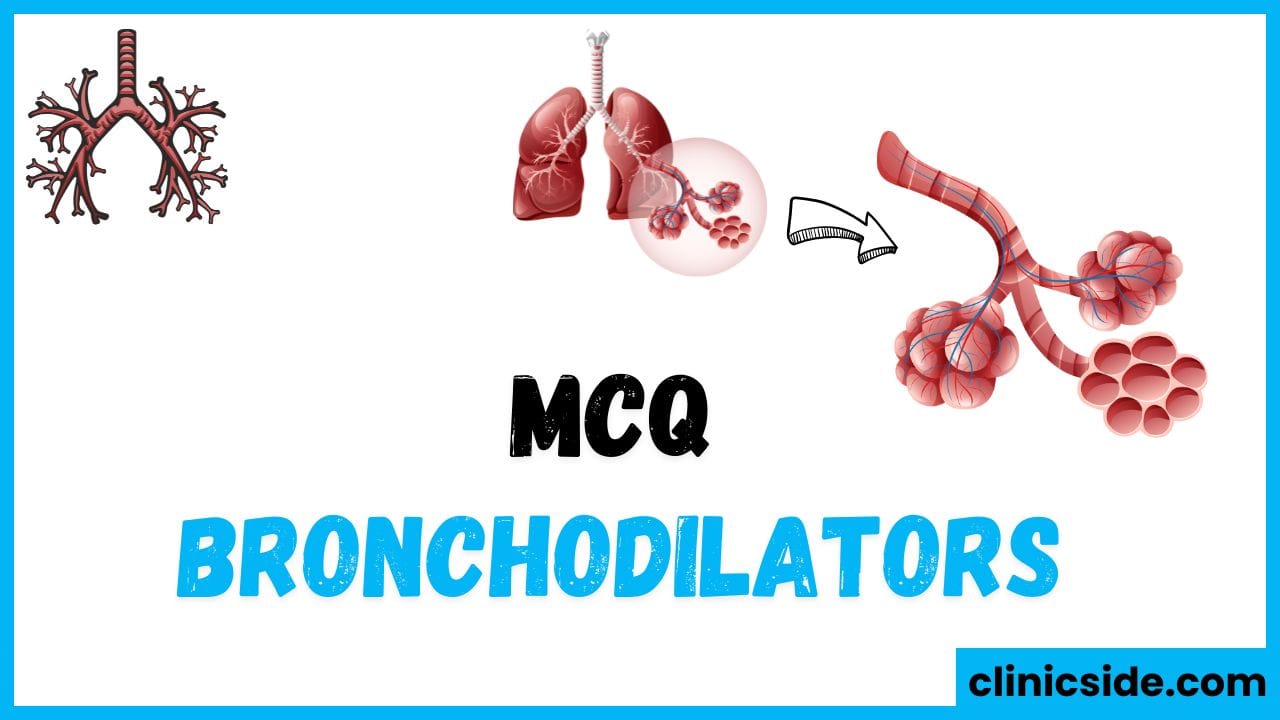Quiz
Available options: 1 to 20
Summary of Beta-Agonists and Bronchodilators MCQs
Classification of Beta-Agonists
Beta-agonists are vital in treating respiratory conditions such as asthma and COPD. They are categorized into short-acting beta-agonists (SABAs) and long-acting beta-agonists (LABAs). SABAs, including Albuterol, act quickly and are ideal for managing acute asthma symptoms. In contrast, LABAs like Salmeterol provide prolonged relief, making them suitable for maintenance therapy, especially in chronic obstructive pulmonary disease. LABAs are not used for immediate symptom relief but are effective in preventing flare-ups when taken consistently.
Mechanism of Action
Beta-agonists achieve their effects by stimulating beta-2 adrenergic receptors in airway smooth muscles. This stimulation increases cyclic adenosine monophosphate (cAMP) levels, which leads to the relaxation of these muscles and improves airflow. This process is fundamental in alleviating breathing difficulties in asthma and COPD. Additionally, anticholinergic drugs such as Tiotropium block muscarinic receptors, preventing airway constriction and contributing to better respiratory function.
Uses of Bronchodilators
Bronchodilators play an essential role in opening up the airways to improve breathing in conditions like asthma and COPD. SABAs, such as Albuterol, are highly effective for immediate symptom relief due to their rapid action. LABAs, including Formoterol, are preferred for long-term symptom control and are often combined with inhaled corticosteroids to enhance their effects. Anticholinergic agents like Ipratropium and Tiotropium are particularly useful in COPD, as they help reduce airway narrowing and mucus secretion.
Contraindications and Precautions
While effective, beta-agonists must be used with caution in certain populations. Hypertension is a significant contraindication, as these drugs can raise heart rate and blood pressure. Individuals with hypokalemia should also be monitored closely, as beta-agonists may further lower potassium levels. Personalized treatment plans and regular monitoring are essential for minimizing risks in these scenarios.
Side Effects of Beta-Agonists
The common side effects of beta-agonists include tremors, increased heart rate, and nervousness, which are caused by their systemic effects on beta-adrenergic receptors. Although these side effects are generally mild, they can become bothersome for sensitive individuals. Anticholinergic medications like Ipratropium are associated with different side effects, such as dry mouth, which can be managed through proper hydration and regular oral care.
Comparison of LABAs and SABAs
LABAs, such as Formoterol, offer quicker relief than Salmeterol while still providing prolonged action. However, SABAs like Albuterol are better suited for immediate relief during acute asthma attacks due to their rapid onset and shorter duration. Understanding these differences is crucial for selecting the right medication based on the patient’s condition and treatment goals.
Role of Anticholinergics
Anticholinergics like Ipratropium and Tiotropium are key drugs in COPD management. Ipratropium, as a short-acting muscarinic antagonist, provides relief during acute exacerbations. Tiotropium, on the other hand, is a long-acting agent that ensures prolonged bronchodilation and helps prevent recurrent COPD symptoms. These drugs are particularly beneficial for individuals who do not respond adequately to beta-agonists alone.
Ultra-Long-Acting Beta-Agonists
Medications like Indacaterol belong to a newer class of ultra-long-acting beta-agonists. These drugs are designed for once-daily dosing, making them convenient and improving adherence among COPD patients. Their extended duration of action provides consistent symptom relief and reduces the need for frequent inhaler use.
Rescue vs. Maintenance Therapy
In asthma treatment, rescue inhalers like Albuterol are essential for quick symptom relief, while maintenance therapy focuses on preventing chronic symptoms and exacerbations. Maintenance regimens often involve LABAs in combination with inhaled corticosteroids for enhanced effectiveness. Theophylline, a phosphodiesterase inhibitor, is occasionally used in treatment but requires careful monitoring due to its narrow therapeutic range.
Considerations for COPD Management
Long-term management of COPD often involves the use of Tiotropium, which provides extended bronchodilation and helps prevent exacerbations. Combining LABAs with anticholinergic agents is a common strategy to improve symptom control. Ultra-long-acting beta-agonists like Indacaterol simplify treatment regimens, making it easier for patients to stay consistent with their medications, ultimately leading to better outcomes.
This summary provides a comprehensive yet unique overview of the roles, mechanisms, and considerations of beta-agonists and bronchodilators in managing asthma and COPD.





